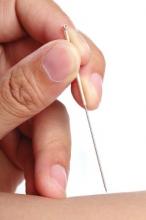SAN ANTONIO – Acupuncture for the reduction of aromatase inhibitor–related musculoskeletal symptoms in breast cancer patients proved a disappointment in an interim analysis of a double-blind, randomized, sham-controlled, multicenter clinical trial.
Both real and sham acupuncture turned out to provide similar reductions in the Health Assessment Questionnaire Disability Index (HAQ-DI), the primary study end point. The two groups also experienced similar improvement in scores on a pain visual analog scale after eight weekly real or sham treatment sessions, Dr. Ting Bao reported at the San Antonio Breast Cancer Symposium.
The double-blind randomized trial included 47 postmenopausal women with early-stage breast cancer who were experiencing musculoskeletal symptoms related to aromatase inhibitor use. None of the patients had received acupuncture in the previous year.
The acupuncture group received eight weekly sessions targeting 15 acupuncture points. The control group got a sham acupuncture procedure at 14 non-acupuncture points. The sham therapy utilized the Park Sham Device, which consists of a nonpenetrating, retractable acupuncture needle and an adhesive tube. From a median baseline HAQ-DI score of 0.75, 8 of 23 patients in the real acupuncture group achieved the minimum clinically important improvement, predefined as a 0.22-point reduction. So did 13 of 24 women in the sham acupuncture group.
Pain scores on a visual analog scale improved to a similar extent in the two study arms, from a baseline median of 50 out of a possible 100 to 41 in the real acupuncture group and 36 in the sham group.
When the blinded patients were asked to guess their treatment assignment, 55% in each group did so accurately, according to Dr. Bao, a medical oncologist and licensed acupuncturist at the University of Maryland Greenebaum Cancer Center, Baltimore.
Plasma estradiol levels remained undetectable in most patients during the study period.
No significant side effects were noted in either study arm.
About half of breast cancer patients on adjuvant aromatase inhibitor therapy experience musculoskeletal symptoms. These side effects can be sufficiently debilitating as to lead to poor compliance or even treatment discontinuation.
Among the possible explanations for the negative results in this study are that the HAQ-DI may not be a sufficiently sensitive tool to detect small differences in effectiveness between real and sham acupuncture, and that sham acupuncture may not be an inert procedure, Dr. Bao said.
Although this randomized trial originally was scheduled to enroll 100 patients, it was halted early for futility based on the interim results.
The study was funded by a Komen grant and an ASCO Young Investigator Award. Dr. Bao declared having no financial conflicts.


